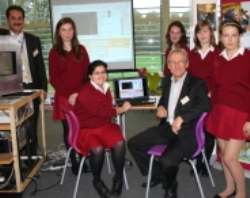Oct 24 2012
Bristol is spearheading a nationwide schools project to shed light on the origin of millions of cosmic rays that crash into the Earth’s atmosphere from outer space.
 Zino Dif, Head of Physics at Red Maids’, and Professor Bob van Eijk with pupils at Red Maids' School
Zino Dif, Head of Physics at Red Maids’, and Professor Bob van Eijk with pupils at Red Maids' School
Red Maids’ School in Westbury-on-Trym is the first school in the South West to link up with the international HiSPARC science initiative, which is being rolled out across the UK by the University of Bristol.
Physics students have built two particle detectors which have been installation onto the roof of their Sixth Form building to help capture intricate data about the strength and direction of high-energy particles that invisibly shower down upon us every second.
Their results will be fed into a central database and accessed by fellow researchers around the globe.
The HiSPARC collaboration, which originated in the Netherlands, aims to find out more about these mysterious high energy particles and where they actually come from.
Zino Dif, Head of Physics at Red Maids’, said: “Very little is understood about these cosmic rays. They could hold information that leads to exciting new discoveries about our universe and human life itself just as research into the Higgs boson led to our understanding of the origin of mass.”
The cosmic ray detectors sit on the roofs of buildings and measure the rate and the energy of the rays, the variations according to the time of day and the angles at which they fall, while also looking for the sources of the rays.
The University of Bristol is already monitoring the high energy particles and has received interest from schools across the country which are keen to get its pupils involved in real, hands-on experimental science.
Dr Jaap Velthuis, Senior Lecturer in the School of Physics, said: “HiSPARC is really popular in Europe, with some countries having a waiting list of schools wanting to take part. This is the first time that a university in the UK has overseen such a programme and it’s been great to see such interest from schools, not just in the South West but also in the Midlands and Hereford.
“We were especially honoured to have Professor Bob van Eijk, who heads up HiSPARC, come over from Amsterdam especially to help us launch the programme at Red Maids’.”
There are also HiSPARC systems operating in the Netherlands, Denmark, Germany, Vietnam and Austria.
The other schools in the West Country which have signed up to the project are:
- Bristol Grammar School
- Royal High School (Bath)
- Beechen Cliff School (Bath)
- Sheldon School (Chippenham)
- New College (Swindon)